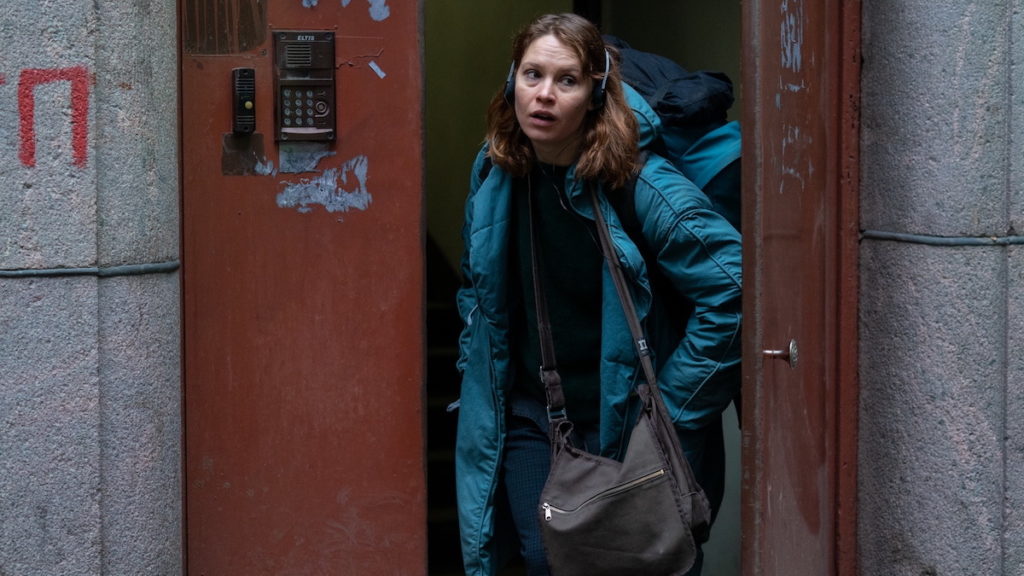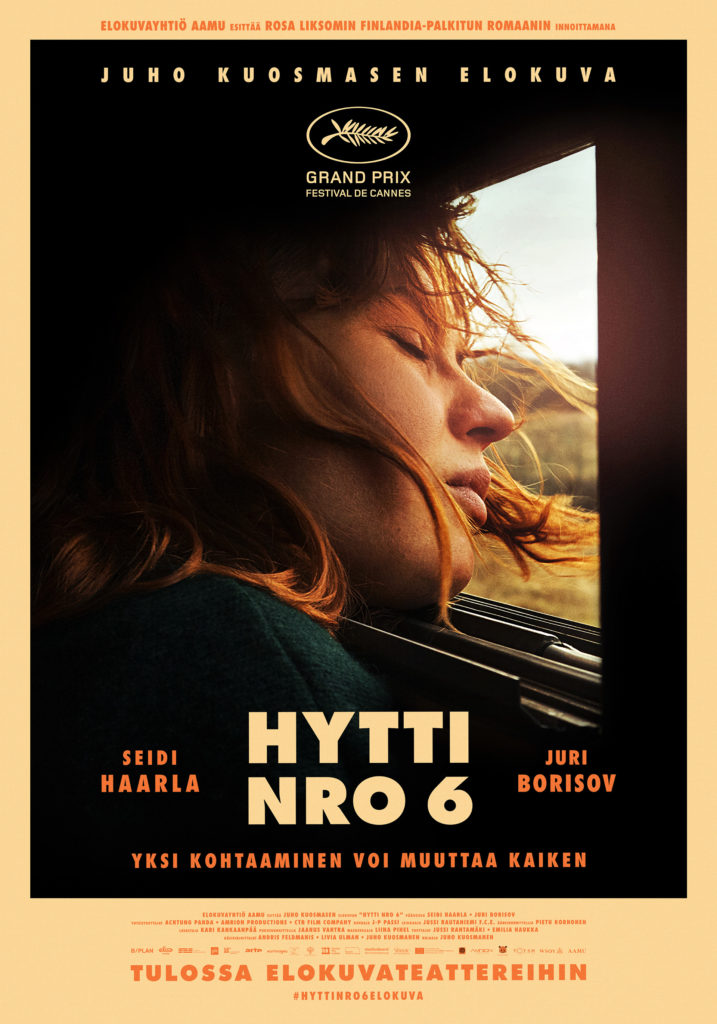火车,电影。
电影,火车。
两者辅车相依的关系可以追溯到电影诞生的时代。根据都市传说,卢米埃尔兄弟的黑白短片《火车进站》,在1896年首映时,观众被直冲着他们而来的真人大小列车的画面吓得惊慌失措。
当然,艺术家对火车的热爱并没有停在十九世纪。早在汤姆克鲁斯之前,巴斯特·基顿在1927年的《将军号》中,为观众演示了高速铁路玩命的特技表演。
以火车到灵感来源的电影在近代史上更是数不胜数。从阿加莎·克里斯蒂的《东方快车谋杀案》,到奉俊昊的雪国列车,还有延尚昊的《釜山行》。
被视为芬兰最值得期待的新导演尤霍·库奥斯以第一部电影《奥利最开心的一天》荣获2016年坎城影展的一种注目奖,2017芬兰角逐奥斯卡最佳外语片代表。 《六号车厢》是此导演的第二部剧情片,今年尤霍开着绿皮火车,邀请我们和女主角劳拉一起踏上孤独、纯真、时而温暖的旅程。改编自芬兰作家罗莎·利克索姆的同名小说。电影入选参加2021年戛纳电影节的金棕榈奖的评比,最终与另外一部电影平分评审团大奖。
《六号车厢》的调性有些暧昧,不过深具写实主义的风格,透过男女主角的眼光描绘与观察描绘90年代的俄国之真实的一面。故事背景很单纯,芬兰学生,劳拉与女友及她知识份子朋友在莫斯科告别后,决定向北极圈迈进,火车驶向联邦内最北、北极圈内最大的不冻港城市 – 摩尔曼斯克。在终点等着她的是柯拉半岛和卡诺泽罗湖的史前岩画。

列车缓缓从莫斯科上车出发,劳拉挑了一个空旷的车厢 – 六号舱。大雪纷飞、寂寞车厢,却冒出一个不识相的旅客。厌世矿工瓦狄姆,一个满嘴脏话的地痞流氓。旅程才开始,瓦狄姆已经喝得酩酊大醉,不但问劳拉是否是妓女,并追她追到厕所。惊慌而后悔的劳拉打电话回在莫斯科的女友艾琳娜,可是发现女友早就已变心。孤独的劳拉决定继续前进,试着和瓦狄姆相处。
导演巧妙地透过手持的摄影机和人物特写镜头,让观众一同和劳拉困在无处可逃的火车上,狭小的车厢充满寂寞的苦味及幽闭恐惧。尤霍的视觉语言不虚华,但就像瓦狄姆大口吞下伏特加一样,无色无味,但三杯入喉便让人欲罢不能,满嘴尽是俄国的柔滑,甘甜与芳香。经过狂饮、宿醉、文化冲击后,通铺火车外大雪纷飞,劳拉和瓦狄姆之间的互动却渐渐温暖起来。两个寂寞灵魂展开一段纯粹而浪漫的感情,镜头所到之处皆是人类本性对爱的渴望,单纯地理解,无条件地支持,互相陪伴度过一段时光。
火车越是颠簸地向北极圈奔驰,手持的摄影机越是更加稳健。颗粒感的35毫米胶片说的是前数字时代的故事,勾起我们对90年代的共同的怀旧之情,也是对美好时代的追缅:劳拉的录音带,冰冷街道上的电话亭,一场挑战未知的旅行。

除了未知,孤独也是电影的主调。
一旦劳拉离开莫斯科的舒适圈时,她与她的爱人断绝了联系,没有智能手机,没有社交软体,她被迫坐在火车的餐厅车厢里跟形形色色的旅客交谈互动,虽然有语言的隔阂,劳拉开始学习人与人之间如何真正地联结。当列⻋旅行结束,劳拉又变回孤身一人,她和瓦狄姆之间脆弱的纽带被分离残酷地打碎,劳拉独自坐在摩尔曼斯克的酒店房间里,她痛苦的孤独感是无形的、不可逃避的重量。
《六号车厢》是室内剧,是公路电影。这列火车,既是隐喻,又是真实的,随着它离莫斯科越来越远,走走停停,伴随着火车本身的晃动,一切的视角和镜头也随之共振。每到一个新的站点,都有新的体验等待着劳拉和瓦迪姆,而当他们重新踏上火车时,他们的车厢就成了一个完美的对手戏的场景。
整体来说,《六号车厢》是一个很简单的故事,不过导演编排精细,人物塑造上的下了很多功夫,导演有意把故事限制在人与人之间的微妙关系上,芬兰知识女留学生遇到了一个俄罗斯流氓矿工,平凡的两人之间爆发出的情感张力竟有山呼海啸之感,充满人性光辉和暖意。
我想到了另一部以火车为起点和终点的伟大电影。理查德-林克莱特的《爱在黎明破晓前》。这两部电影乍一看毫无关联,但在观看了《6号车厢》之后,你将无法否认:他们都希望向真挚人性致敬。

影评人简介
贝尔纳多·莱特(Bernardo Leyte),常驻巴黎的电影制作人。 他在西班牙、德国和英国长大,毕业于伦敦电影学院,目前担任导演。 他是一位充满热情的影迷,他所观看的电影囊括各种类型,从他的偶像斯坦利·库布里克(Stanley Kubrick)和安德烈·塔可夫斯基(Andrei Tarkovsky)的電影,到超级英雄、恐怖片、动漫等。

Trains and cinema, cinema and trains. There are few pairings that go so well together, that so naturally share the same DNA as celluloid and the steel machines do: from the beginning of film history, before commercial flights began, there were already trains hurtling towards the screen and, according to urban legend, making the viewers back away in fear. Later, there was Buster Keaton attempting death-defying stunts atop a steam engine in The General before Tom Cruise, action man for hire, was even invented. In modern times, we have seen murders on trains as written by Agatha Christie and post-apocalyptic Snowpiercers ploughing through the ice and… who could forget about the Korean zombies heading to Busan?
Compartment No. 6 is the second feature film by Juho Kuosmanen, the Finnish director who won the Un Certain Regard section of the Cannes Film Festival in 2016 with The Happiest Day in the Life of Olli Mäki. This year, he has delivered another train film into the canon of cinema, and has been rewarded with the Grand Prix (ex-aequo) at Cannes for his efforts. The product, a tender adaptation of the source novel by the same name, is about a young Finnish woman taking the railway line from Moscow to Murmansk, and it is a train movie to remember, full of intimate moments of human grace and beauty that linger in the mind long after leaving the darkness of the cinema.
Compartment No.6 never tries to make its point bluntly; it is a character study where the protagonists have time to simply exist and interact in the Russia of the late 90s where the story is set. The premise is simple: Laura, a Finnish student, leaves her lover Irina and her circle of intellectual friends in Moscow behind and sets out on a trip to Murmansk, in the arctic circle, hoping to see the famous Kanozero petroglyphs in the Kola Peninsula. On the train, she realises that she must share her compartment with Vadim, a thuggish man who looks like any woman- or guy’s – worst nightmare for a travel companion. In the first few hours, Vadim has already gotten wasted, asked Laura if she’s a whore and chased her into the toilets. Scared and wanting to turn back, she phones Moscow and comes to a second realisation: her love towards Irina is probably not as reciprocal she thought. Alone and dejected, she choses to get back on the train and tough it out with her bunkmate.
Laura’s loneliness and the claustrophobic feeling of being trapped inside the narrow hallways of the train are stylistically conveyed with an ever-present handheld camera in tight close up shots that make the viewer feel like there is nowhere to turn. The cinematography has no unnecessary flourishes, but it is as efficient and to the point as the vodka Vadim chugs down on the first night on the train. Vadim, of course, has more inside him than the raging Russian ethanol coursing through his veins, and once the “culture clash” of the first night passes and the hangover sets in, the unlikely pair in compartment number 6 begins to warm up towards each other and pave the way for an unexpectedly dear relationship.
The handheld camerawork continues, but turns steadier and more poised even as the train trudges on towards the arctic circle. The grainy 35mm cinematography and the pre-digital era setting make for a welcome serving of 90s nostalgia. A cassette tape that Laura rewinds with a pencil, phone booths planted in freezing streets and the sheer feeling of taking off on your own and diving into the unknown without easy answers are markers of a bygone era that’s presented with affection but not glorified.
Indeed, loneliness is a key aspect of the film. When Laura leaves the comfort of Moscow, she is also, to all effects, breaking off communication with her lover, and she cannot immediately pick up her smart phone and send status updates. Sitting at the train’s restaurant car, she has to interact with the assorted cast of characters that are on the same journey for one reason or another. When she needs help from the perma-frowning conductor, it’s clear that her imperfect Russian makes it more difficult to communicate. And when, after a special bond is formed, it suddenly breaks off, Laura sits alone in her hotel room in Murmansk and her aching isolation is palpable, filling every space with invisible, inescapable weight.
Compartment No.6 is a chamber drama and a road movie. The train, as metaphorical as it is real, stops at different Russian locales as it gets farther from Moscow. With every new stop, new encounters await Laura and Vadim, and when they step back into the train, their compartment becomes the setting for a perfect two-hander play. Structurally, technically, Compartment No.6 is a simple story that does its job well. Where director Juho Kuosmanen excels is in the absolute humanity that he and his two lead actors manage to extract from this meeting of two polar oposite beings. Like any great artist, Kuosmanen is able to create something that feels so tangible and real precisely because of all the crafty filmmaking engineering underneath the surface that pulls the story and its characters along the tracks. Another great film that begins and ends on a train comes to mind: Before Sunrise, by Richard Linklater. The two films could not be more different at first glance, but after having watched Compartment No.6, you won’t be able to deny the obvious; they are both great films about the rarest of things; human connection.

About the Author
Bernardo Leyte (Vigo, Spain) is a Paris-based filmmaker. He grew up in Spain, Germany and the UK, graduating as a director from the London Film School. He is a passionate cinephile whose eclectic film playlist includes a bit of everything, from his idols, Kubrick and Tarkovsky, to superheroes, horror, anime and everything in between.

